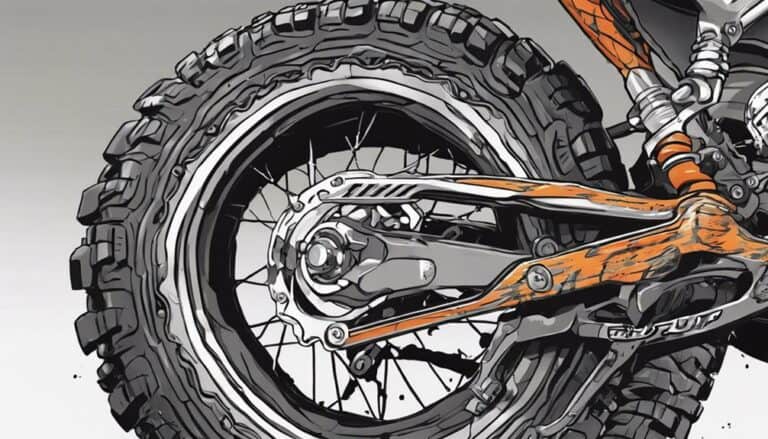As you glance at the tire of a Trail Breaker dirt bike, the simple rubber exterior may give little indication of the complex components hidden within.
Have you ever wondered what lies beneath the surface, contributing to the tire's performance and durability on rugged trails?
Exploring the inner workings of this essential part can uncover a world of engineering precision and innovative design that keeps you rolling smoothly through challenging off-road adventures.
Key Takeaways
- Tire composition includes specialized rubber layers for off-road durability.
- Inner tubes provide cushioning and maintain optimal air pressure.
- Proper tire pressure crucial for stability, traction, and fuel efficiency.
- Tread patterns vary for specific terrains, optimizing grip and control.
Tire Composition
Comprising layers such as the tread, sidewall, and inner liner, the tire of a Trail-Breaker dirt bike is a meticulously engineered component essential for excellent off-road performance. Constructed from specialized rubber compounds, the tire is fortified with materials like steel, nylon, or Kevlar to enhance strength and durability. These materials are strategically chosen to withstand the rugged demands of off-road riding, providing riders with confidence in various terrains.
The rubber compounds used in the tire's construction are formulated to optimize traction, ensuring a firm grip on loose or uneven surfaces. This enhanced traction not only improves stability but also contributes to the bike's overall performance. Additionally, the tire's design incorporates features that resist punctures, reducing the likelihood of unexpected flats during your adventures.
Understanding the tire composition empowers you to make informed decisions regarding maintenance and replacement. By monitoring wear patterns, maintaining proper inflation, and recognizing the importance of the inner tube for cushioning and air retention, you can maximize your dirt bike's performance and longevity.
Inner Tube Function
The inner tube in a Trail-Breaker dirt bike tire functions as a critical inflatable cushion responsible for maintaining ideal air pressure levels. This rubber component sits between the tire and the wheel, acting as a barrier to prevent air leakage and sustain the tire's shape under varying terrains.
Inner tubes are known for making off-road rides smoother by absorbing shocks and impacts, enhancing control and stability. One key element to note is the rim lock, which secures the inner tube within the tire and prevents it from slipping during intense rides.
Proper care and maintenance of the inner tube are essential to make sure the tire performs well and has a long lifespan. By regularly inspecting for punctures, making sure the correct air pressure, and using appropriate tire levers during installation, you can maximize the lifespan of the inner tube and enjoy a more reliable off-road biking experience.
Tire Pressure Importance
Maintaining the correct tire pressure on your Trail-Breaker dirt bike is essential for peak performance and safety. Here are the key reasons why tire pressure is crucial:
- Handling Benefits: Proper tire pressure ensures optimal contact with the ground, enhancing traction and cornering capabilities. This results in improved control and maneuverability, especially on challenging terrains.
- Safety Implications: Incorrect tire pressure can lead to compromised stability, longer braking distances, and an increased risk of accidents. By maintaining the right tire pressure, you enhance overall safety while riding your Trail-Breaker dirt bike.
- Performance Impact: The performance of your dirt bike is directly affected by tire pressure. Well-inflated tires reduce rolling resistance, improve fuel efficiency, and provide a smoother ride. Ensuring the correct tire pressure according to manufacturer recommendations is vital for maximizing the performance capabilities of your Trail-Breaker dirt bike.
Tread Patterns Explained
Properly understanding the tread patterns on your Trail-Breaker dirt bike tires is fundamental for optimizing performance across various terrains. Tread depth variations play a vital role in determining how the tire interacts with the ground. Deeper treads provide enhanced traction in challenging off-road conditions, while shallower treads offer better performance on hard-packed surfaces. Traction technology incorporated into the tread design guarantees a reliable grip on different types of terrain, enhancing stability and control for the rider.
Specifically designed for mud performance characteristics, some tread patterns feature widely spaced knobs to prevent mud buildup, maintaining traction in muddy conditions. These patterns promote self-cleaning, preventing loss of grip due to mud clogging. By choosing a tread pattern tailored to your riding style and the terrains you frequent, you can optimize the handling, cornering, and braking capabilities of your Trail-Breaker dirt bike, ensuring a thrilling and safe riding experience.
Tubeless Vs. Tubed Tires
In off-road applications like the Trail Breaker dirt bike, the choice between tubeless and tubed tires greatly impacts performance and maintenance. When considering which type of tire to use on your Trail Breaker, it's essential to weigh the pros and cons of each:
- Tubeless Tires:
- *Pros*: Better puncture resistance, reduced weight, no inner tube needed.
- *Cons*: Initial setup can be more complicated, potentially more expensive, require specific sealants.
- Tubed Tires:
- *Pros*: Easier to repair in the field, cheaper to replace, simpler setup.
- *Cons*: More susceptible to pinch flats, heavier due to the inner tube, increased risk of punctures.
When it comes to maintenance tips, tubeless tires may require more attention to sealant levels and potential leaks, while tubed tires need regular checks of the inner tube for wear or damage. To help you decide, here's a quick comparison chart:
| Aspect | Tubeless Tires | Tubed Tires |
|---|---|---|
| Puncture Resistance | High | Lower |
| Weight | Lighter | Heavier |
| Repair Ease | Easier | Simpler setup |
Conclusion
As you ride the Trail Breaker dirt bike, remember that the tire is your connection to the terrain, like a lifeline tying you to the earth.
The composition, function, and pressure of the tire all collaborate to guarantee a smooth and safe ride.
Whether you opt for tubeless or tubed tires, understanding their inner workings will enhance your riding experience and keep you rolling on the trails with confidence.

